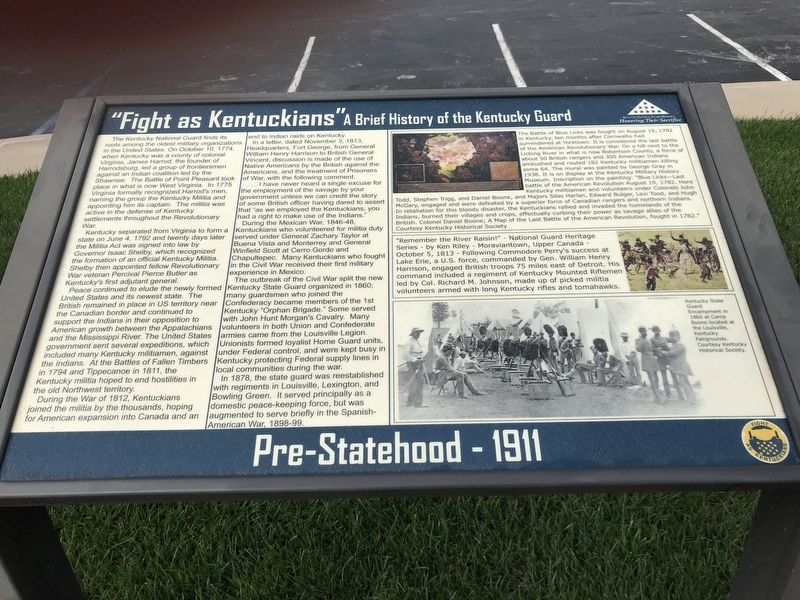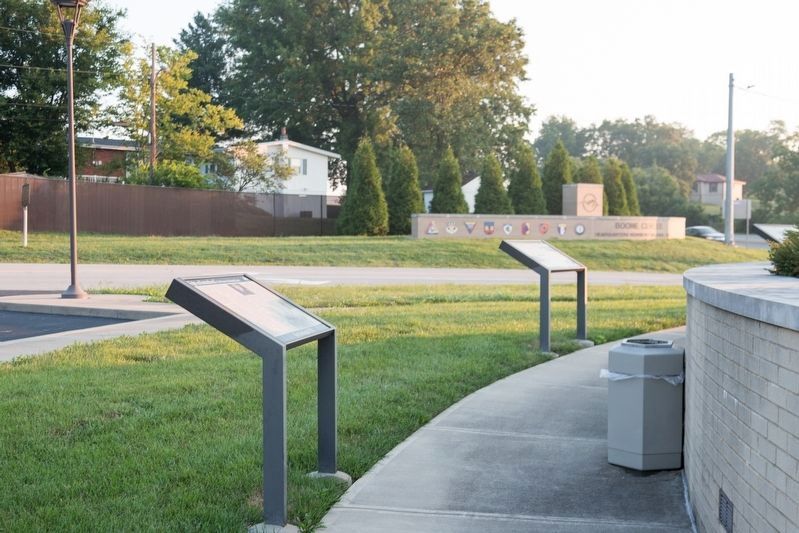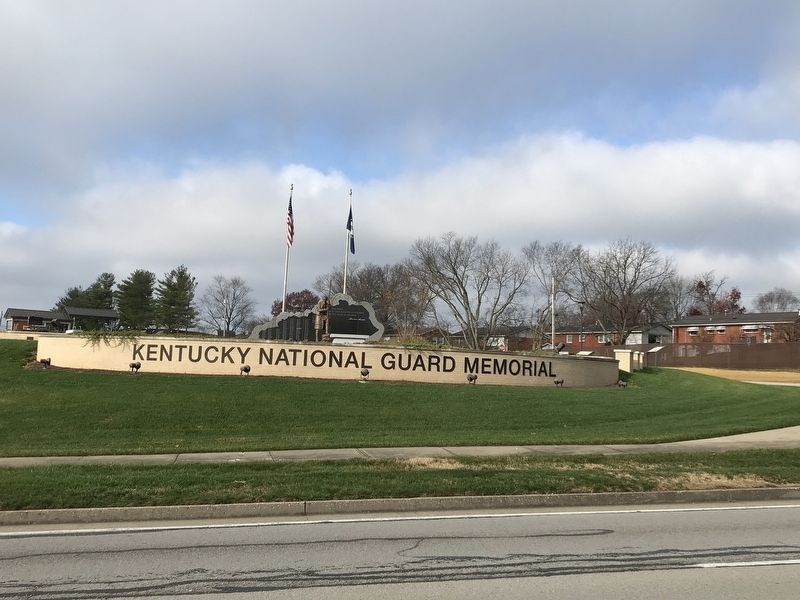Frankfort in Franklin County, Kentucky — The American South (East South Central)
"Fight as Kentuckians"
A Brief History of the Kentucky Guard
— Pre-Statehood - 1911 —
Kentucky separated from Virginia to form a state on June 4, 1792 and twenty days later the Militia Act was signed into law by Governor Isaac Shelby, which recognized the formation of an official Kentucky Militia. Shelby then appointed fellow Revolutionary War veteran Percival Pierce Butler as Kentucky's first adjutant general.
Peace continued to elude the newly formed United States and its newest state. The British remained in place in US territory near the Canadian border and continued to support the Indians in their opposition to American growth between the Appalachians and the Mississippi River. The United States government sent several expeditions, which included many Kentucky militiamen, against the Indians. At the Battles of Fallen Timbers in 1794 and Tippecanoe in 1811, the Kentucky militia hoped to end hostilities in the old Northwest territory.
During the War of 1812, Kentuckians joined the militia by the thousands, hoping for American expansion into Canada and an end to Indian raids on Kentucky.
In a letter, dated November 3, 1813, Headquarters, Fort George, from General William Henry Harrison to British General Vincent, discussion is made of the use of Native Americans by the British against the Americans, and the treatment of Prisoners of War, with the following comment:
...I have never heard a single excuse for the employment of the savage by your government unless we can credit the story of some British officer having dared to assert that "as we employed the Kentuckians, you had a right to make use of the Indians."
During the Mexican War, 1846-48, Kentuckians who volunteered for militia duty served under General Zachary Taylor at Buena Vista and Monterrey and General Winfield Scott at Cerro Gordo and Chapultepec. Many Kentuckians who fought in the Civil War received their first military experience in Mexico.
The outbreak of the Civil War split the new Kentucky State Guard organized in 1860; many guardsmen who joined the Confederacy became members of the 1st Kentucky "Orphan Brigade.” Some served with John Hunt Morgan's Cavalry. Many volunteers in both Union
and Confederate armies came from the Louisville Legion. Unionists formed loyalist Home Guard units, under Federal control, and were kept busy in Kentucky protecting Federal supply lines in local communities during the war.
In 1878, the state guard was reestablished with regiments in Louisville, Lexington, and Bowling Green. It served principally as a domestic peace-keeping force, but was augmented to serve briefly in the Spanish-American War, 1898-99.
Sidebars
Top right: The Battle of Blue Licks was fought on August 19, 1782 in Kentucky, ten months after Cornwallis had surrendered at Yorktown. It is considered the last battle of the American Revolutionary War. On a hill next to the Licking River in what is now Robertson County, a force of about 50 British rangers and 300 American Indians ambushed and routed 182 Kentucky militiamen killing some 64. The mural was painted by George Gray in 1938. It is on display at the Kentucky Military History Museum. Inscription on the painting: "Blue Licks-Last battle of the American Revolution August 19, 1782. Here Kentucky militiamen and volunteers under Colonels John Todd, Stephen Trigg, and Daniel Boone, and Majors Silas Harlan, Edward Bulger, Levi Tood, and Hugh McGary, engaged and were defeated by a superior force of Canadian rangers and northern Indians. In retaliation for this bloody disaster, the
Kentuckians rallied and invaded the homelands of the Indians, burned their villages and crops, effectually curbing their power as savage allies of the British. Colonel Daniel Boone; A Map of the Last Battle of the American Revolution, fought in 1782." Courtesy Kentucky Historical Society
Center right: "Remember the River Raisin!” - National Guard Heritage Series - by Ken Riley - Moraviantown, Upper Canada - October 5, 1813 - Following Commodore Perry's success at Lake Erie, a U.S. force, commanded by Gen. William Henry Harrison, engaged British troops 75 miles east of Detroit. His command included a regiment of Kentucky Mounted Riflemen led by Col. Richard M. Johnson, made up of picked militia volunteers armed with long Kentucky rifles and tomahawks.
Caption (bottom right) Kentucky State Guard Encampment in 1860 at Camp Boone located at the Louisville, Kentucky Fairgrounds. Courtesy Kentucky Historical Society.
Erected by Kentucky National Guard.
Topics. This historical marker is listed in this topic list: Military. A significant historical date for this entry is October 10, 1774.
Location. 38° 11.303′ N, 84° 53.665′ W. Marker is in Frankfort, Kentucky, in Franklin County. Marker can be reached from the intersection of Minuteman Parkway and West Frankfort Connector. Marker is at Kentucky National Guard Memorial at entrance to Boone National Guard Center. Touch for map. Marker is at or near this postal address: 101 Minuteman Parkway, Frankfort KY 40601, United States of America. Touch for directions.
Other nearby markers. At least 8 other markers are within walking distance of this marker. A different marker also named "Fight as Kentuckians" (here, next to this marker); a different marker also named "Fight as Kentuckians" (a few steps from this marker); History of Memorial Project (a few steps from this marker); Daniel Boone (a few steps from this marker); a different marker also named "Fight as Kentuckians" (a few steps from this marker); Kentucky National Guard Memorial (a few steps from this marker); Lewis and Clark in Kentucky — Kentucky Militia (within shouting distance of this marker); Welcome to Kentucky's Capitol and Capital (approx. 0.8 miles away). Touch for a list and map of all markers in Frankfort.
Related markers. Click here for a list of markers that are related to this marker.
Credits. This page was last revised on August 31, 2021. It was originally submitted on December 5, 2020, by Duane and Tracy Marsteller of Murfreesboro, Tennessee. This page has been viewed 218 times since then and 30 times this year. Photos: 1. submitted on December 5, 2020, by Duane and Tracy Marsteller of Murfreesboro, Tennessee. 2. submitted on August 31, 2021, by J. J. Prats of Powell, Ohio. 3. submitted on December 6, 2020, by Duane and Tracy Marsteller of Murfreesboro, Tennessee.


